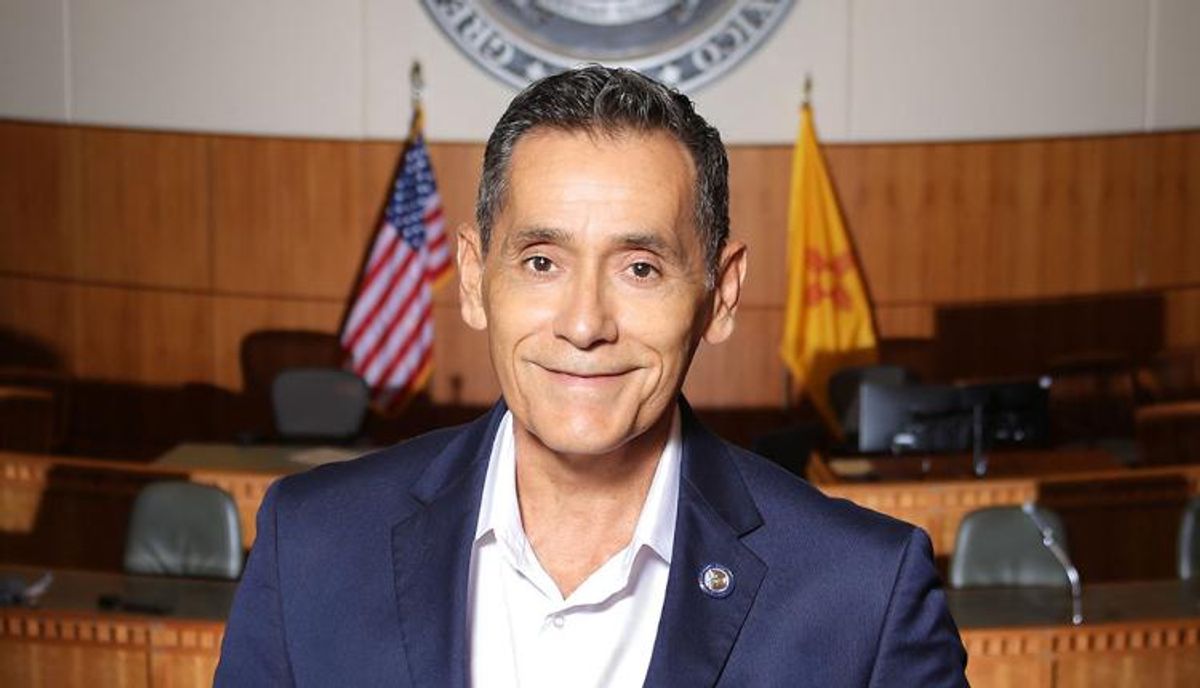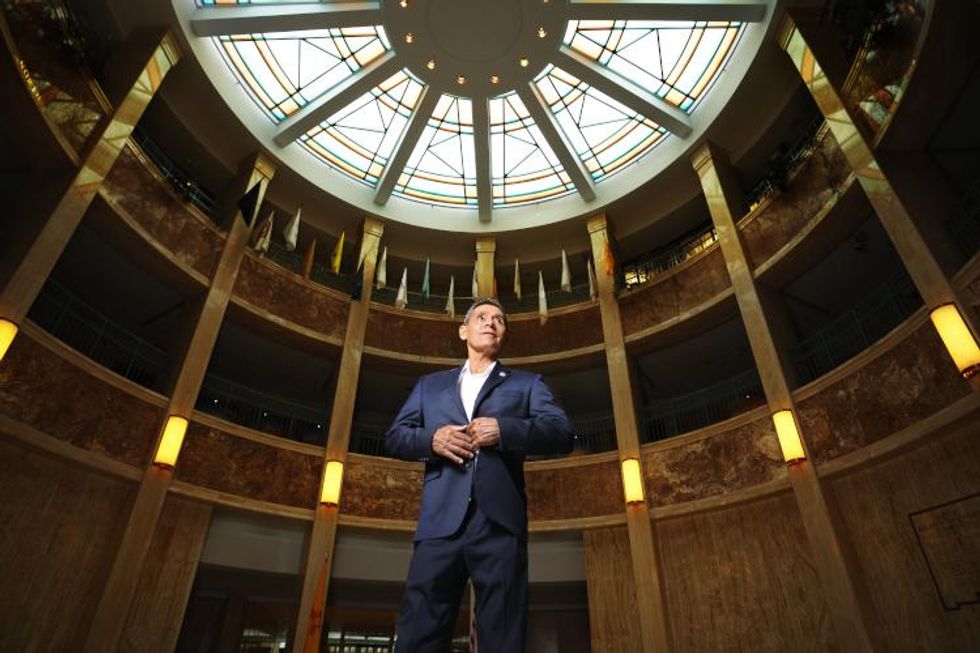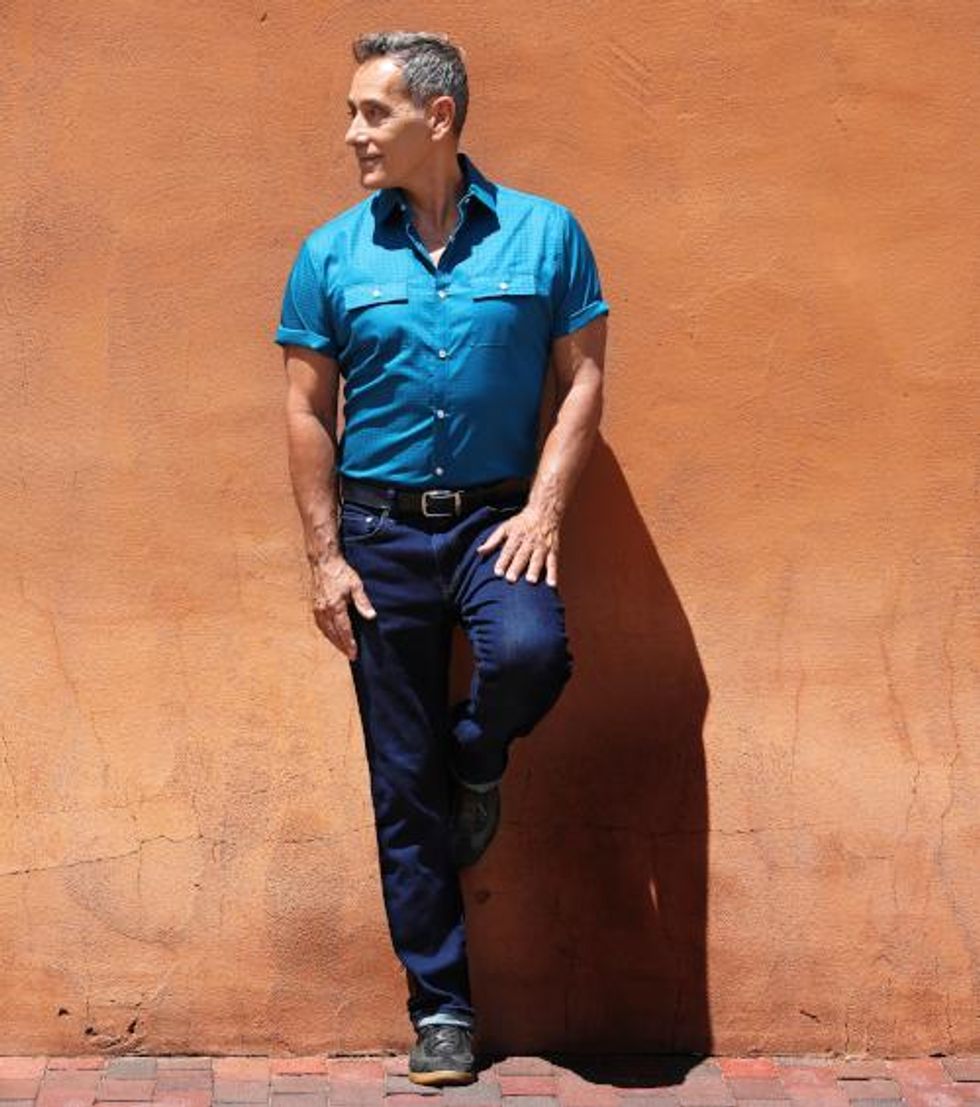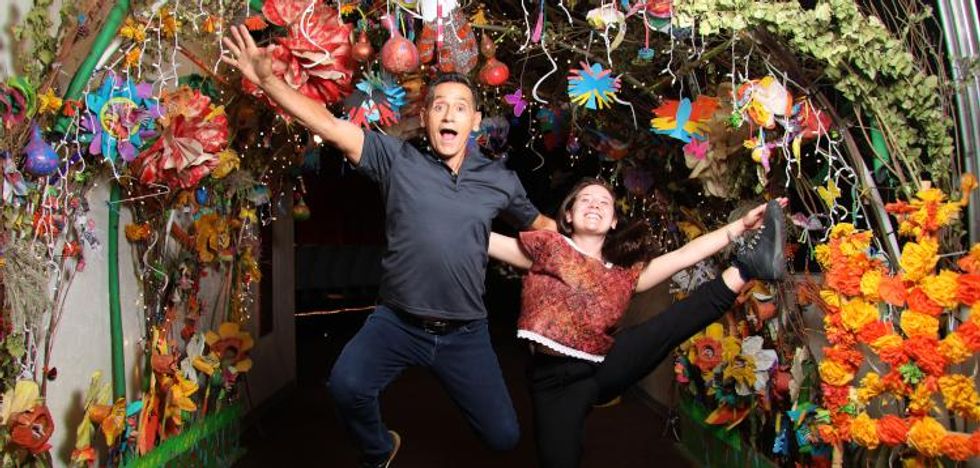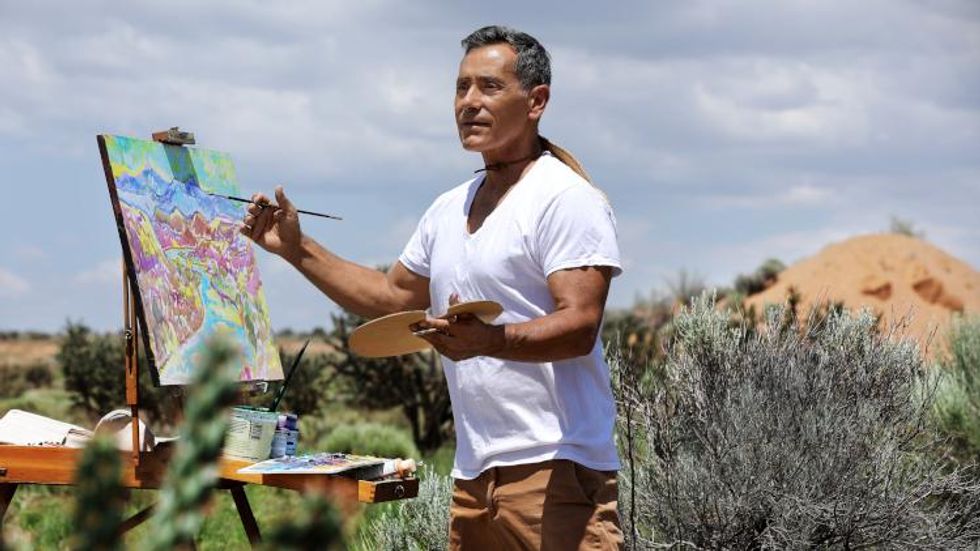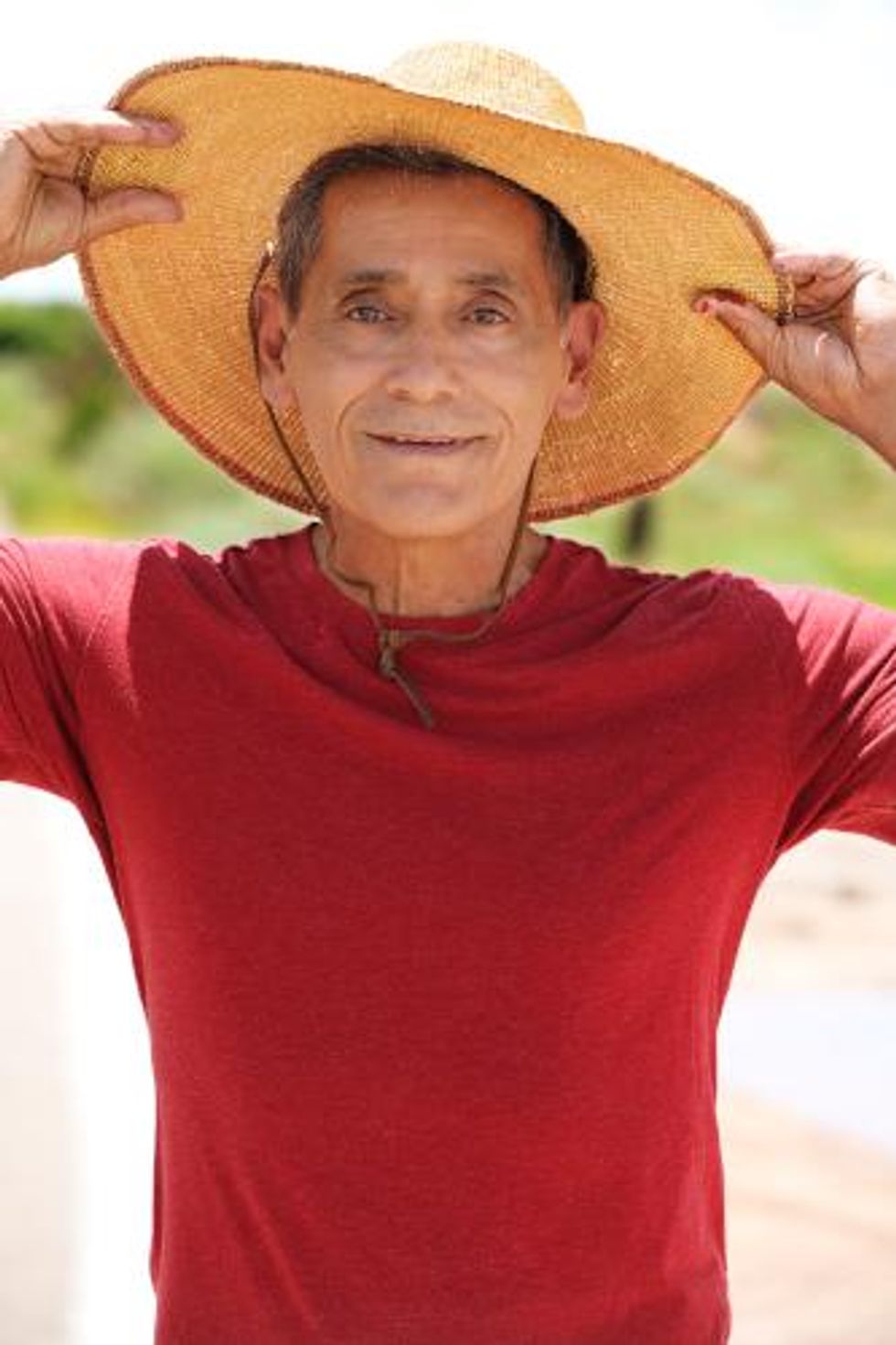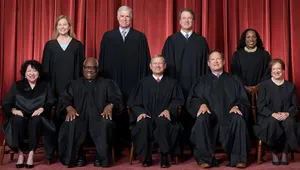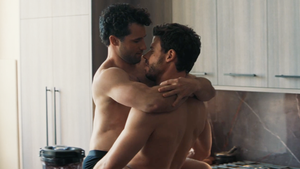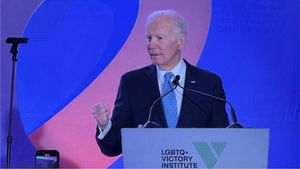“I’m beyond humbled,” are among the first words from recently-elected New Mexico state representative Roger Montoya as he sat down recently to chat with us for our Latinx issue’s cover feature. This immediately clues you in what kind of person Montoya is — and is continually reinforced as we get to know him and his incredible journey to the halls of power.
For much of his early life, working in politics was never really on his radar. In his youth, Montoya was a skilled gymnast who nearly reached the Olympics had it not been for a career-ending injury. From there, he studied dance and the visual arts at various high-profile institutions across the country. Eventually, Montoya (alongside life partner Salvador Ruiz-Esquivel) went on to be honored a one of ten CNN Heroes in 2019 and became the first out gay and HIV-positive representative in New Mexico’s history.
Looking back now, the 60-year-old artist and humanitarian says he realized at a young age, “maybe 4 or 5,” that he stood out amongst his peers and was labeled a “sissy” early on. He recalls hearing uncles whispering that “he was not a real man” to other family members in Spanish, thinking he couldn’t understand.

Growing up in Denver, Montoya describes his younger self as “extremely precocious, mischievous, ultra-kinetic, cartwheeling — zipping here, zipping there. But my internal landscape was very different. I was very shy, painfully shy.”
“And so I think,” he continues, “my flitting and zipping about was natural, but it caused reaction from homophobic uncles that was contrary to the [the joy of it]. I tried to suppress it. That was sort of the conflict with self that I experienced. But I also felt this joy and excitement for moving in the world. That’s why I was put into gymnastics very early.”
Despite the inner turmoil caused by early brushes with homophobia, Montoya says his parents supported his passion and his years as a young athlete took him far. At 14, he went to the 1976 Summer Olympics training camp in Romania, also attended by five-time Olympic gold medalist Nadia Comăneci (famous for scoring a perfect 10), a dream come true for the aspiring gymnast.
“The ’68 Olympics and then the ’72 Olympics were monumental and life changing for me because I saw Olga Korbut do her routines,” recalls Montoya. “And so my mother and father were very excited that I love something so much. And I was good.”
Throughout his high school years, he continued traveling and competing in gymnastics which ultimately brought him to the West coast. After suffering a severe concussion doing a double-back flip, he decided to quit the sport and shift his focus to dance. The next decade or so of Montoya’s life was eventful, a path full of high peaks and dark valleys as a deadly new “gay cancer” began to ravage his community.
“I was only 18 years old,” he continues. “I met a man who was 35 and he ended up dying of GRID, gay-related immuno-deficiency. He was my first continual sexual partner…and so I contracted HIV probably in ’79, ’80, even though there wasn’t a test until ’86.”

Unfortunately this was just the beginning of the death and devastation that the initial AIDS epidemic would bring over the next decade and a half. Despite the miraculous fact that Montoya had managed to stay healthy during these pre-antiretroviral years, other than “a little weight loss here and there, a debilitated spirit, and low T cells,” he witnessed firsthand the darkest realities of the virus.
“Around ’82, ’83, I met another man, Bob, who died in 1986 of AIDS [complications],” Montoya says. “And by then, by the time of his death, it had been named AIDS…. I decided to come home to New Mexico about a year before he died — he was still well enough and he met my parents and saw the land where I now live. He lived for a brief period…. His parents who had ostracized him early in his life, their only child, decided to warm up a little bit because now their son was terminal with this new gay cancer. They gave him some money, and my parents gave us the land in the back. And we started what became the house that I now live in today, a beautiful home. Bob gave me a gift of starting a home in my early 20s.”
After his partner passed, Montoya moved to New York on a dance scholarship.
“Those were my first incredible experiences,” he says. “It just was just an amazing time of growth and excitement. But looming in the background was my own [HIV status]. Right after Bob died here in New Mexico, my mother, being the astute nurse that she is, had me tested…. And so we did it, and we cried. And, you know, it was clear that it didn’t look good for me, at that point in ’86…. I ended up getting my own apartment and started auditioning with Paul Taylor Dance Company, Martha Graham, Twyla Tharp…and I just was immersed in this beautiful world of contemporary dance in the city. But at the same time, hundreds of men are dying. It became critical in [the late ’80s]. So by ’89, after a tour of Europe with Parson’s company…I was starting to feel depressed. I was starting to feel the debilitating physical effects and went to Brooklyn and got a doctor and my T cells were about 60.”

“It was a…it was a hard moment,” Montoya continues, emotion welling up in his voice. “It was really hard because we were losing top dancers in the company…and I just been through Bob’s horrific death…it was just horrible.”
Overwhelmed by the grief and trauma, and believing that he would soon die too, Montoya decided to return to New Mexico to live out his final days with his parents. But to his surprise, not only did he not die — he began to thrive.
“I figured if I’ve got a couple, three, four, or five years, max,” he says. “I would be there in the house that I started with Bob in the early ’80s and right next to my parents who are now in their 60s and 70s. I thought, You know what? They need me, I need them, I’m leaving this thing, my life is over. I’m just gonna go back and die. And what happened was quite the contrary, it was amazing. And it wasn’t easy right away, but I started painting, which had been a parallel interest my entire life…. And so when I returned, and the air was clean and I could think straight, and there were beautiful young people around that needed the kind of light that I had just come from. These kids are talented, this place is beautiful, the population is tiny. I was struggling in New York, working at the Boys and Girls School and the Jewish school, and teaching here and selling cheese at Dean & DeLuca — whatever I could do to survive — and I came back and I had this bucolic life, of being with my parents and seeing the potential of New Mexico.”

Montoya went on to cofound several organizations, including his youth-based nonprofit Moving Arts Española (MovingArtsEspanola.org), which he started with his partner, Ruiz-Esquivel. The after-school program offers visual and performing arts education, free healthy meals, and academic support for the children and youth of northern New Mexico.
Last November, Montoya was elected New Mexico state representative for District 40 near Santa Fe, despite a GOP-led smear campaign that unearthed his brief, long-ago past in adult entertainment. He addressed the rumors head on, stating he had starred in two adult films as a 22-year-old struggling college student and dancer in Los Angeles “nearly 40 years ago, in a very different time and climate,” and went on to win the seat.
These days, now eight months into his elected position, Montoya is focused on improving life for those living in rural areas of New Mexico, who he says need the state’s help most.
“I put together this really large, big picture about rural New Mexico…because rural areas are underserved,” he explains. “So it’s an infrastructure bill that I pushed really hard for because the largest cities garner all the funding…. There has not been an investment in rural infrastructure in our state since the Eisenhower era. And the work that Biden is doing right now is absolutely in alignment [with this].”

Montoya says he credits his mother in a lot of ways for gearing him toward political action, as well as his grandmother and all the strong Latinas he knew growing up for helping him realize that being a “sissy” really isn’t an insult after all.
“I admired women growing up, when I was called the mujerero [sissy], it was because I always clung to the aunts and the tias and the older cousins and the grandmothers. When the boys were throwing balls and breaking windows and cussing and fighting, I was sitting under the kitchen table, listening to their conversations and their strength and their strategy to survive — men that were beating them and alcoholics…. They always were action-oriented to do what they need to do to survive for the family, or the individual, whatever the case may be. And I think that instilled this really graceful power, that sort of a divine feminine quality that, being called and teased as a sissy, I later in life said to myself, You know what, this is pretty darn cool — who you are, how you move, how you speak, you’re a dancer, you’re an artist. This is who you are. It’s your fingerprint — live it.”
Montoya adds, “I think…watching those [AIDS-related] deaths up close and personal, literally in my arms, was essentially instructive to a life…. Go for it, don’t hold back, I had lived a life that was worth living, and there were lessons to help others and my mother was very much part of that…. She said, ‘We have to fight. We have to open these doors to help the people see and to survive — because you’re here.’ She and I were just co-patriots, all the way.”
